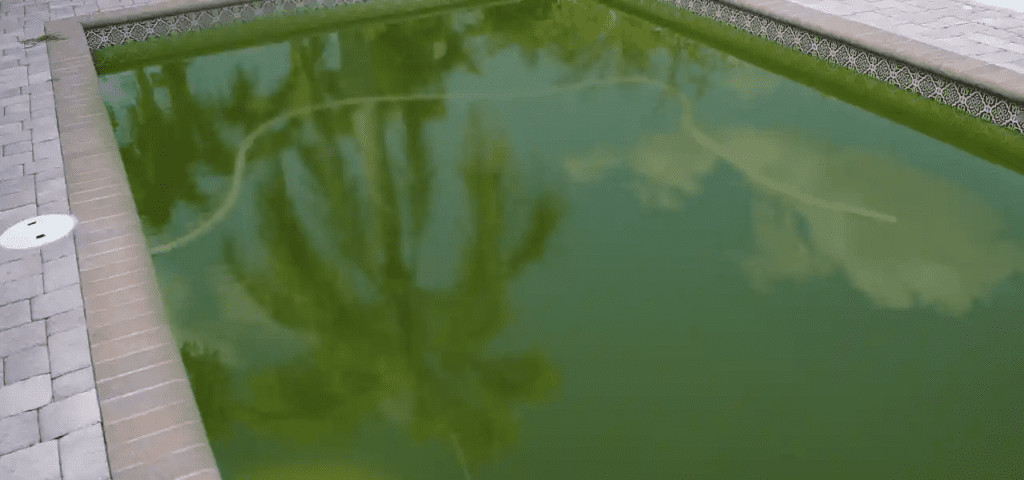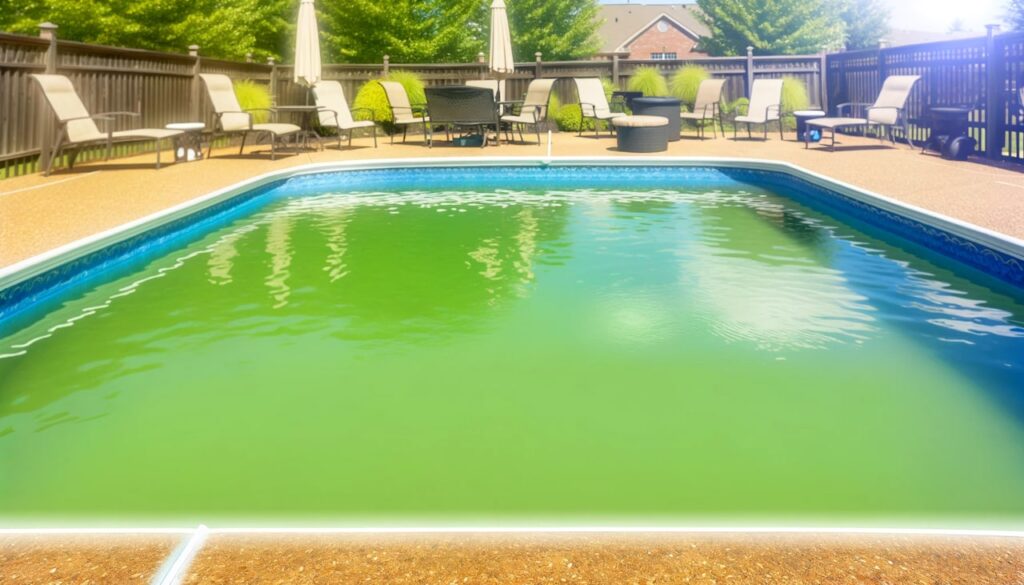If your pool water is green and cloudy, high phosphate levels might be the culprit. Excessive phosphates can promote algae growth and complicate the maintenance of proper pool chemistry. Read on to understand more about phosphates, the importance of keeping their levels low, and how to reduce phosphate levels in your pool.
What are Phosphates in a Pool?
Phosphates are organic compounds that naturally enter your pool from sources like dead leaves, lawn fertilizer, and other debris. When phosphate levels become too high, they provide nutrients for algae, causing your pool water to turn green and cloudy.
Phosphates can enter your pool from common sources like rainwater, leaves, and even swimmer lotions. These everyday items can contribute to phosphate levels in your pool water.
Completely eliminating phosphates from your pool is impractical, but the key is to keep their levels low enough to prevent algae growth.

Is high phosphate in the pool dangerous?
High phosphate levels in a pool are not directly dangerous to swimmers, but they can indirectly create unsafe conditions. Phosphates act as a nutrient for algae, promoting its growth. This can turn the pool water green and cloudy, reducing visibility and potentially making the pool slippery, which increases the risk of accidents. Additionally, algae growth can interfere with proper pool chemistry and sanitation, making it harder to maintain clean and safe water. While phosphates themselves are not harmful, their presence can lead to conditions that compromise pool safety and hygiene.
Read More Blog: How to Test for Phosphates in Pool?
How to Remove Phosphates in a Pool
Removing phosphates from your pool is essential for preventing algae growth and maintaining clear water. By following a series of steps, including testing, cleaning, and chemical treatments, you can effectively manage phosphate levels and ensure a healthier swimming environment.
-
- Test Phosphate Levels
Regularly testing your pool’s phosphate levels is the first step in managing and reducing them. Use a reliable phosphate test kit to measure the concentration of phosphates in your pool water. This will give you a clear indication of whether your pool’s phosphate levels are within a manageable range or if they are too high. Testing should be done frequently, especially after heavy rainfall, high winds, or significant organic debris entering the pool. Keeping a close watch on these levels allows you to take timely action, ensuring your pool remains clear and free from algae-promoting nutrients.
-
- Clean the Pool and Filtration System
Keeping your pool and its filtration system clean is crucial for reducing phosphate levels. Start by skimming the surface of the pool to remove leaves, insects, and other debris that can decompose and release phosphates. Vacuum the pool floor regularly to eliminate dirt and organic matter. Additionally, backwash or clean your pool filter to ensure it operates efficiently, as a clogged filter can harbor phosphates. Regular cleaning prevents the buildup of organic materials that contribute to high phosphate levels, thus helping to maintain a cleaner and healthier pool environment.
-
- Use a Phosphate Remover
Using a phosphate remover is an effective way to reduce high phosphate levels in your pool. Phosphate removers are chemical treatments designed to bind with phosphates, making them easy to filter out of the water. To use a phosphate remover, follow the product instructions, typically adding the recommended amount directly to the pool water. Allow the pool’s filtration system to circulate the water thoroughly, which helps in removing the bound phosphates. Regular application of a phosphate remover can significantly lower phosphate levels, preventing algae growth and maintaining clearer, healthier pool water.
-
- Balance Pool Chemistry
Balancing your pool’s chemistry is essential for effective phosphate management and overall water quality. Ensure that chlorine levels are maintained within the recommended range to keep algae and bacteria at bay. Monitor and adjust pH levels, alkalinity, and calcium hardness to create an environment where pool chemicals can work effectively. Properly balanced pool chemistry not only helps in controlling phosphate levels but also enhances the efficiency of other treatments, such as phosphate removers. Regular testing and adjustment of these chemical levels are key to preventing algae growth and maintaining a healthy swimming environment.
-
- Maintain Regular Pool Maintenance
Consistent and thorough pool maintenance is vital for keeping phosphate levels low and ensuring a clean swimming environment. Develop a routine that includes skimming the surface, vacuuming the pool floor, brushing the walls, and cleaning the filtration system. Regularly check and maintain appropriate chemical levels, including chlorine, pH, and alkalinity. Performing these tasks on a consistent basis prevents the accumulation of organic debris that can release phosphates. By staying on top of pool maintenance, you can effectively manage phosphate levels and enjoy a clear, inviting pool all season long.
-
- Prevent Phosphate Introduction
Preventing phosphates from entering your pool is a proactive approach to maintaining low levels. Be mindful of the environment around your pool: trim back overhanging trees to reduce leaf fall, and manage landscaping to minimize fertilizer runoff into the pool. Use a pool cover when the pool is not in use to keep out debris and contaminants. Educate pool users about rinsing off grass, dirt, and lotions before entering the pool. By taking these preventive measures, you can significantly reduce the introduction of phosphates, making it easier to maintain clear and healthy pool water.
Do Phosphates Cause Algae Growth In Pools?
One of the most common questions about spa and pool algae is whether phosphates cause algae growth. The short answer is maybe.
Phosphates serve as a food source for algae, so high levels in pool water can promote algae growth. However, the presence of high phosphates in a pool or hot tub does not guarantee algae will grow. Algae can still develop in pools or spas with no phosphates, and phosphates alone do not necessarily lead to algae growth. Other factors, such as water temperature, sunlight, and chlorine levels, also play significant roles in the process.
Phosphates are a primary food source for algae? High phosphate levels in your pool can significantly increase the likelihood of algae blooms, turning your pool water green and cloudy.

Testing for phosphates & algae
Testing kits for chlorine, pH, and other chemical levels in a pool are widely available, but not all include a method for testing phosphate levels. For this, you can purchase a separate swimming pool phosphate testing kit. Alternatively, you can take a water sample to a pool professional for analysis. It’s important to note that high phosphates in your pool are not necessarily a cause for alarm, as phosphates and algae do not always directly correlate with algae growth in spa or pool water. Other factors also contribute to the likelihood of algae developing.
How To Address Algae If Phosphates Aren’t The Issue
While high levels of phosphates in a hot tub or swimming pool are not ideal, they are unlikely to cause significant issues if you manage other factors that contribute to algae growth. Phosphates are unavoidable, particularly in outdoor pools, no matter how much testing or chemical control you implement. Therefore, spending money on swimming pool phosphate removers is generally unnecessary.
Instead, take these simple steps to prevent algae growth:
- Frequently empty the skimmer and pump baskets.
-
- Keep the filter clean.
-
- Vacuum dirt and debris as needed.
It’s impossible to completely eliminate phosphates from your pool? Even with rigorous cleaning and maintenance, some level of phosphates will always be present, especially in outdoor pools.
Should High Phosphates Be Removed From The Swimming Pool?
Some pool professionals and chemical salespeople promote the notion that algae blooms can only be controlled by removing phosphates from your pool. As a result, many pool owners overspend on swimming pool phosphate removers, believing this will solve the problem. However, because other factors influence the relationship between phosphates and algae, simply using a phosphate remover is not the complete answer. Effective algae control requires addressing multiple aspects of pool maintenance, not just phosphate levels.

Conclusion
Phosphates in a pool are organic compounds that, while not directly harmful to swimmers, can promote algae growth if levels become too high. Managing phosphates involves a combination of regular testing, cleaning the pool and filtration system, using a phosphate remover if necessary, balancing pool chemistry, and maintaining consistent pool maintenance. While high phosphate levels are a factor in algae growth, they are not the sole cause. Effective algae control requires addressing various factors, including water chemistry and debris management. Therefore, while it’s important to monitor and manage phosphates, they should not be the sole focus of pool maintenance strategies.
Frequently Asked Questions
1. Where do pool phosphates come from?
Pool phosphates come from various sources, including leaves, grass clippings, fertilizers, detergents, and rainwater runoff. These organic materials decompose and release phosphates into the pool water.
2. How do I test pool phosphate levels?
You can test pool phosphate levels using a phosphate test kit, which is available at most pool supply stores. Alternatively, take a water sample to a pool professional for analysis.
3. Are phosphates bad for your pool?
Phosphates themselves are not harmful to swimmers, but high levels can promote algae growth, making it harder to maintain clear and clean pool water.
4. Can you swim in a pool with high phosphates?
Yes, you can swim in a pool with high phosphates. However, high phosphate levels can lead to algae growth, which can affect water clarity and quality.
5. What to do About Phosphates in a Salt Water Pool
In a saltwater pool, manage phosphates by regularly testing and cleaning the pool, using a phosphate remover if necessary, and maintaining balanced water chemistry to prevent algae growth.
6. What are phosphates in a pool?
Phosphates are organic compounds that can enter the pool from various sources, acting as nutrients that promote algae growth if levels become too high.
7. What causes high phosphates in a pool?
High phosphates in a pool are caused by decomposing organic matter, such as leaves and grass clippings, as well as fertilizers, detergents, and rainwater runoff.
8. How to check the phosphate level in pool?
Check phosphate levels in your pool using a dedicated phosphate test kit available at pool supply stores, or have a sample tested by a pool professional.
9. How to use phosphate remover in pool?
To use phosphate remover, follow the product instructions, typically adding the recommended amount to the pool water and allowing the filtration system to circulate it thoroughly.
10. What happens if you put too much phosphate remover in pool?
If you put too much phosphate remover in the pool, it can cause water cloudiness and potentially disrupt water chemistry. Follow manufacturer guidelines to avoid overuse.


